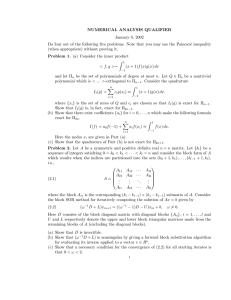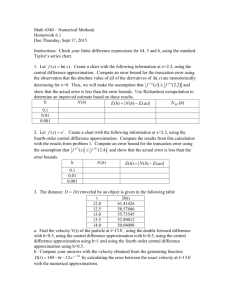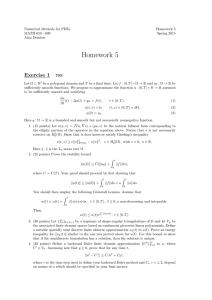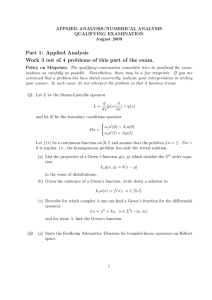Finite element approximation of the Navier-Stokes Equation Mioara Boncut¸
advertisement
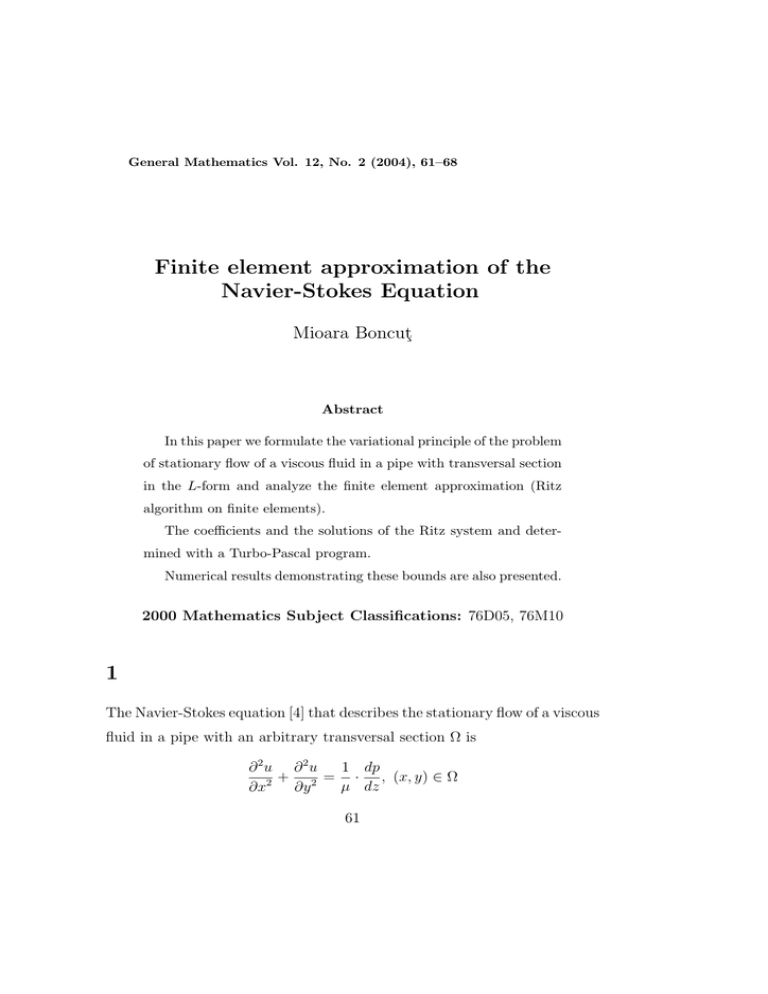
General Mathematics Vol. 12, No. 2 (2004), 61–68
Finite element approximation of the
Navier-Stokes Equation
Mioara Boncuţ
Abstract
In this paper we formulate the variational principle of the problem
of stationary flow of a viscous fluid in a pipe with transversal section
in the L-form and analyze the finite element approximation (Ritz
algorithm on finite elements).
The coefficients and the solutions of the Ritz system and determined with a Turbo-Pascal program.
Numerical results demonstrating these bounds are also presented.
2000 Mathematics Subject Classifications: 76D05, 76M10
1
The Navier-Stokes equation [4] that describes the stationary flow of a viscous
fluid in a pipe with an arbitrary transversal section Ω is
∂ 2u ∂ 2u
1 dp
· , (x, y) ∈ Ω
2 +
2 =
µ dz
∂x
∂y
61
62
Mioara Boncuţ
dp
is the pressure
dz
fall on the length of the pipe. The problem is to determine the repartition
where u is the velocity, µ is the coefficient of viscosity and
of the velocity in the section Ω.
We consider the boundary value problem
Lu ≡ −∇2 u = f in Ω ⊂ R2
(1)
u = 0 on ∂Ω.
By using the Gauss formula in C2 (Ω), the following integral identity is
verified by classical solution u:
Z
Z
T
∇ u · ∇vdΩ = f vdΩ, ∀v ∈ C01 (Ω)
(2)
Ω
Ω
(C0 (Ω) = {u ∈ C 1 (Ω)|u = 0 on ∂Ω}).
Let us introduce the fundamental Hilbert space and its norm as
H01 (Ω) = {u ∈ H 2 (Ω), u = 0 on ∂Ω}
Z
2
||u||H 1 (Ω) = |∇u|2 dΩ (≡ ||u||21,0 ).
0
Ω
n
where H (Ω) is the Sobolev space on Ω.
The triplet (H, a, ϕ), where H is the Hilbert space, can now be introduced
as follows
H = H0′ (Ω)
a(u, v) =
Z
∇T u · ∇vdtΩ, ∀u, v ∈ H01 (Ω)
Ω
ϕ(v) =
Z
f vdΩ, ∀v ∈ H01 (Ω).
Ω
It is easy to prove that the form a(u, v) is a bilinear symmetrical functional, boundary, coercive, and the functional ϕ(v) is a linear and bounded
form.
63
Finite element approximation of the Navier-Stokes Equation
In this conditions, (2) can be represented as
a(u, v) = ϕ(v), ∀v ∈ H01 (Ω).
(3)
Definition 1.1. The integral identity (2) is normed weak equation for the
boundary value problem 1 and the function u ∈ H01 (Ω) for which (2) hold is
named weak solution.
From the Lax-Milgram theorem the problem (3) has a solution u and it is
unique.
Theorem 1.1. The weak solution of u is the unique point of minimum of
the functional
1
F (u) = a(u, u) − (f, u).
2
Thus the solving of the problem (1.3) is equivalent to the following minimization problem [2]:
Find u ∈ H01 (Ω) such that
(Pv )
F (u) ≤ F (v), ∀v ∈ H0′ (Ω)
The purpose of this paper is to analyze the finite element approximation
S
of (Pv ). Let Ωh be a polynomial approximation of Ω defined by Ωh ≡
τ,
τ ∈T h
h
h
where T is a partition of Ω into a finite number of disjoint open regular
triangles τ , each of maximum diameter bounded above by h. In addition,
for any two distinct triangle, their closure are either disjoint, or have a
common vertex, or a common side. Let {Pj }N
j=1 be the vertices associated
with the triangulation T h , where Pj has coordinates (xj , yj ). Throughout
we assume that Pj ∈ ∂Ωh implies Pj ∈ ∂Ω and that Ωh ⊆ Ω. The following
finite dimensional space is associated to T h :
n
o
S h = v ∈ C(Ωh ), v|r is linear ∀τ ∈ T h ⊂ H ′ (Ωh ).
64
Mioara Boncuţ
: C(Ωh ) → S h denote the interpolation operator such that for
Q
Q
any v ∈ C(Ωh ), the interpolant h v ∈ S h satisfies h v(Pv ) = v(Pj ), j =
Let
Q
h
1, 2, ..., N.
The finite element approximation of (Pv ) that we shall consider is
Find uh ∈ S0h such that
(Pvh )
F (uh ) ≤ F (v h ), ∀v h ∈ S0h
where S0h = {v ∈ S h : v = 0 on ∂Ωh }.
The solution of the variational problem (Pvh ) is determined using the Ritz
method with finite elements through the procedure of local approximation
and assembly.
The approximate solution is chosen for the finite element τ as follows:
uhr = {N (x, y)}Tτ {U }hτ
(4)
where {N } and {U } represent the column vectors of the local linear basis
for the element τ and of the nodal values of the approximate solution:
{N }Tτ = (N1 N2 N3 ); {U }hτ = (U1 U2 U3 )T
where
Nr =
1
(ar + br x + cr y); Ur = uhτ (xr , yr ), r = 1, 2, 3
2∆r
ai = xj yk − xk j; bi = yj − yk ; ci = −(xj − xk ) with permutation i → j → k,
∆τ being the area of the finite element τ .
Now we invoke the principle of stationary functional energy F τ = F (uhτ ):
∂F τ
= 0, r = 1, 2, 3.
∂ur
We obtain the matrix equation on the τ element (Ritz system) in the
form:
(5)
[R]τ {U }hτ = {P }τ .
65
Finite element approximation of the Navier-Stokes Equation
In this case we have
[K]r =
b21 + c21
b1 b2 + c 1 c 2 b1 b3 + c 1 c 3
1
2 2
b1 b2 + c 1 c 2
b
c
b
b
+
c
c
2 3
2 3 .
2 2
4∆r
b1 b3 + c 1 c 3 b2 b3 + c 2 c 3
b23 + c23
Remark 1.1. We note that the matrix [K]τ is the same for all the elements
if the following local counting is used (fig.1).
3
1
2
2
1
3
Fig. 1
1
The column vector {P }τ is {P }τ = f ∆
. The coefficients of the
1
3
1
matrix {P }τ are determined by using the local coordinates (L1 , L2 , L3 ) of
the point P (x, y) and the formula
a
1
Iαβγ =
∆τ
b
where
Iαβγ ≡
Z
Lα1 Lβ2 Lγ3 dτ = 2∆c
α!β!γ!
.
(α + β + γ)!
τ
An equation of the type (5) is written for each element. The column
vector {U }hτ is extended to the N number of nodes in the mesh by the
66
Mioara Boncuţ
introduction of all the nodal values. Taking into account the correspondence
between the local counting and the overall counting the matrices [K]τ and
{P }τ are also extended at dimensions N × N and N × 1. We obtain the
matrix of the mesh
(6)
[K] · {U } = {P }
to which we attach conditions on main boundary.
The coefficients kij and pi of the matrices [K] and {P } and the solutions of the Ritz system (by means of the Gauss elimination method) are
determined with a Turbo-Pascal program. The program has been applied
for the following numerical example:
µ = 1, 5 · 10−4 N s/m2 ;
dp
= −5000N/m3 ;
dz
Ω in L − form (fig.2);
a = 0, 1m.
y
S
0
a
x
z
Fig. 2
67
Finite element approximation of the Navier-Stokes Equation
The values of velocity at nodes are listed in Table 1, in the case N = 51.
0.00
0.00
0.00
0.00
0.00 4866.45
4884.50
0.00
0.00 7253.47
7308.98
0.00
0.00 8481.01
8670.66
0.00
0.00 9164.11
9807.93
0.00
0.00 9431.55 11615.97
8368.64
0.00
0.00
0.00
7008.61 5013.84 0.00
0.00 8567.15 11271.05 10467.33 9165.95 6517.56 0.00
0.00 5792.50
0.00
0.00
7690.83
7637.64
0.00
0.00
6872.63 4989.36 0.00
0.00
0.00
0.00
Table 1. Numerical results for velocity.
References
[1] Baretti J. W., Liu W. B., Finite element approximation of the
p-Laplacian, Math. Comp., vol. 61, 1993, 523 - 537.
[2] Berdicevski V. L., Variaţionnı̂e prinţipı̂ mehanikipleşnoi sredı̂, Moskova,
1983.
[3] Boncuţ M., Brădeanu P., Some error estimates for finite element method
applied to Navier-Stokes equation, 3rd INternational Conference on
Boundary and Finite Element, Constanţa - May 1995, vol. 3, 86 - 92.
[4] Boncuţ M., A variational method applied to the Navier-Stoke Equation,
International Conference on Approximation and Optimization, ClujNapoca - July 1996, vol. 2, 29 - 32.
68
Mioara Boncuţ
[5] Pironneau O., Methodes des elemtes finis pour les fluides, Recherches en
Mathematiques Appliquees, Paris, 1988.
”Lucian Blaga” University of Sibiu
Department of Mathematics
Str. Dr. I. Raţiu, No. 5-7
550012 - Sibiu, Romania
E-mail address:mioara.boncut@ulbsibiu.ro

